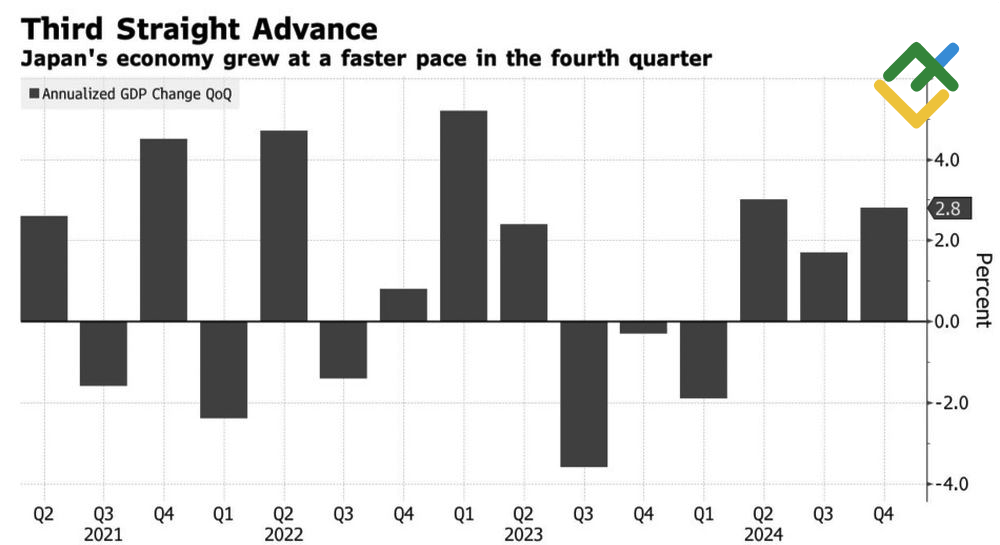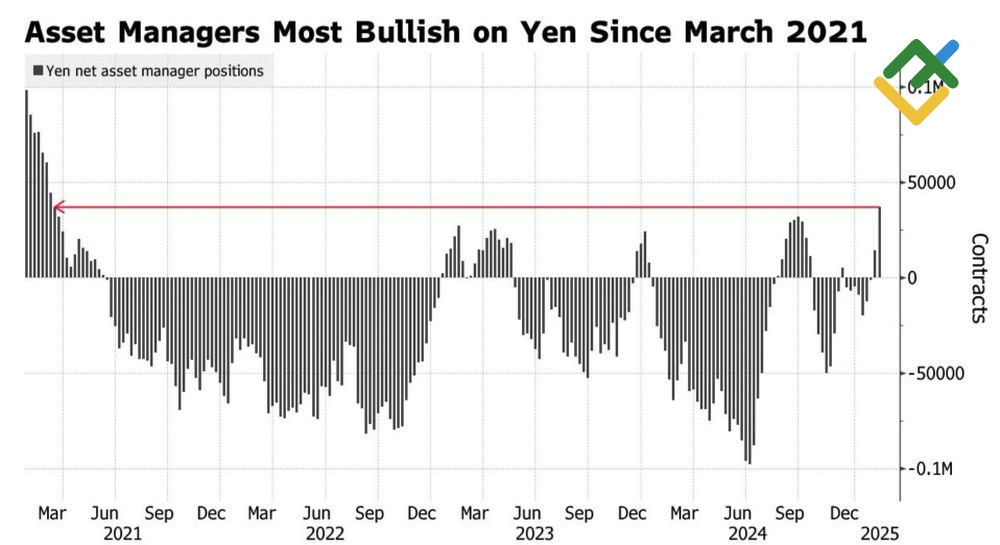
In light of the recent significant rate cuts by most major central banks worldwide, the Bank of Japan’s decision to maintain its rates has led to a shift in market sentiment, favoring a bearish outlook for the EURJPY and GBPJPY exchange rates. Let’s discuss this topic and make a trading plan.
The article covers the following subjects:
Major Takeaways
- The yen is supported by robust GDP and PPI data.
- The euro and the pound look vulnerable due to rate cuts.
- Markets give an 80% chance of a BoJ rate hike by July.
- Short trades on the EURJPY and GBPJPY pairs can be opened on a dip below 158.9 and 190.7, respectively.
Weekly Fundamental Forecast for Yen
The US dollar’s strength appeared to be short-lived. Long trades on the USDJPY pair opened at 152.45 have brought modest profits. After rising by more than 200 pips, the pair collapsed, demonstrating that the US dollar was vulnerable due to Donald Trump’s empty tariff threats, the US Treasury’s intention to reduce Treasury note yields, and an unexpected drop in US retail sales. The pair’s quotes returned to the two-month low, particularly in light of the yen’s anticipated strength in 2025.
In contrast to the US, the Japanese economy continues to show robust growth. In the fourth quarter, Japan’s GDP surged from 1.7% to 2.8%, surpassing Bloomberg’s estimate of 1.1%. The growth rate of prices for corporate goods reached its highest point in the last 19 months, further supporting the ongoing normalization cycle by the Bank of Japan.
Japan’s GDP Growth
Source: Bloomberg.
According to the latest forecasts, there is an 80% likelihood of an overnight rate increase by July, with a high degree of confidence in a further tightening of monetary policy by September. In light of the significant cuts in borrowing costs implemented by other central banks, the yen is poised to be a top gainer on Forex this year. Since the beginning of January, the yen has strengthened by more than 3.5% against the greenback.
Notably, speculators have increased their net-long positions in the Japanese currency, reaching the highest levels in the past four years.
Speculative Positions on Japanese Yen
Source: Bloomberg.
The yen is strengthening against the US dollar at a faster rate than against other G10 currencies, which at first glance appears illogical. The Fed has paused the monetary easing cycle, which, on paper, should give the greenback some leverage. However, it is losing its allure as investors no longer believe in Donald Trump’s policies.
The market has been convinced that universal tariffs would have been implemented long ago. In fact, Trump was bluffing and offered substantial duty waivers and deferrals. Investors realize that threats are part of Trump’s negotiating tactics. As a result, US dollar pairs face significant volatility. Other pairs appear less volatile and more suitable for trading strategies that employ a monetary policy divergence.
Therefore, expectations of three acts of monetary expansion from the European Central Bank and the Bank of England, occurring on the background of at least one overnight rate hike by the BoJ, create a perfect opportunity for selling the euro and the pound against the yen. The European currencies surged on positive rumors of peace talks in Ukraine, but this process risks dragging on.
Weekly EURJPY and GBPJPY Trading Plan
Therefore, traders may avoid excessive uncertainty surrounding Donald Trump’s tariffs and capitalize on monetary policy divergences by selling the EURJPY and GBPJPY pairs on breakouts of support levels of 158.9 and 190.7, respectively.
This forecast is based on the analysis of fundamental factors, including official statements from financial institutions and regulators, various geopolitical and economic developments, and statistical data. Historical market data are also considered.
Price chart of EURJPY in real time mode
The content of this article reflects the author’s opinion and does not necessarily reflect the official position of LiteFinance broker. The material published on this page is provided for informational purposes only and should not be considered as the provision of investment advice for the purposes of Directive 2014/65/EU.
According to copyright law, this article is considered intellectual property, which includes a prohibition on copying and distributing it without consent.
{{value}} ( {{count}} {{title}} )
This post is originally published on LITEFINANCE.





